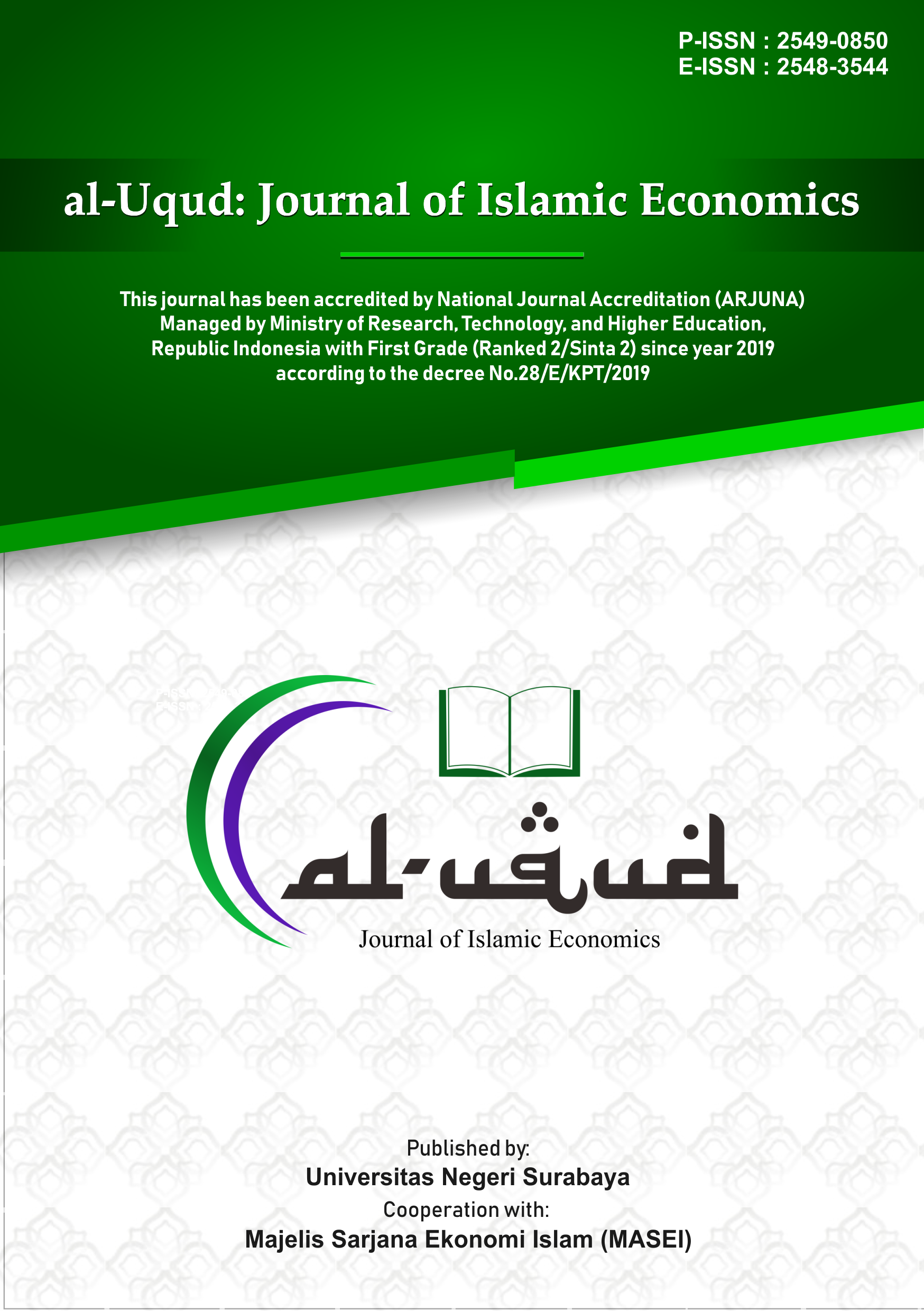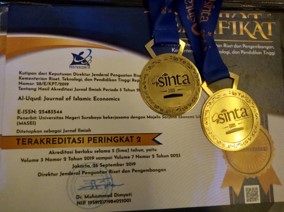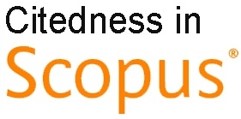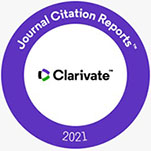An effort to increase waqf intention: The role of celebrity endorsers in social campaigns
DOI:
https://doi.org/10.26740/aluqud.v7n2.p154-171Keywords:
Celebrity endorser, Wakif image, Wakif credibility, Endowment intentionAbstract
The waqf is a fascinating research topic in Islamic economics (sharia). The massive potential for collecting waqf donations in Indonesia has yet to be maximised. Using celebrities as endorsers in waqf campaigns is one of the strategic solutions to increase people's intention to donate waqf. This study aims to identify the effect of the three attributes of celebrity endorsers on waqf intentions, with image and credibility as mediating variables. The research method used is quantitative, using SEM-PLS as an evaluation model. The respondents used were aged 17 years to> 65 years, with a total of 400 respondents. The variables of this study were measured using a 5-point Likert scale. This study concluded that all exogenous variables positively and significantly affected Nazhir's image and credibility. Likewise, the image and credibility variables of Nazhir are proven to positively and significantly affect the waqif's intention to donate waqf. In the IPMA analysis results, it was found that Nazhir's expertise and credibility were the variables with the highest level of importance and performance, in effect, the intention to donate. This research can be the basis for Nazhir's reference to being able to devise strategies for using celebrities as endorsers in supporting social campaigns by focusing on the expertise and knowledge of religion possessed by celebrity endorsers as the main criteria.
References
Ab Hamid, S.N., Maulan, S. and Wan Jusoh, W.J. (2022), "Brand attributes, corporate brand image and customer loyalty of Islamic banks in Malaysia", Journal of Islamic Marketing, Vol. ahead-of-print No. ahead-of-print. https://doi.org/10.1108/JIMA-09-2021-0309
Ali, H., Purwandi, L., Nugroho, H., Ekoputri, A. W., & Halim, T. (2017). Indonesia Middle Class Muslim: Religiosity and Consumerism. Jakarta: Alvara Research Center.
Arshad, S., Ikram, M., Yahya, M., & Nisar, Q. A. (2017). Does celebrity endorsement influence the corporate loyalty: Mediating role of corporate credibility. International Journal of Social Sciences, Humanities and Education, 1(4), 308-319.
Bargoni, A., Giachino, C., Battisti, E. and Iaia, L. (2023), "The effects of influencer endorsement services on crowdfunding campaigns", Journal of Services Marketing, 37(1), 40-52. https://doi.org/10.1108/JSM-12-2021-0444
Battour, M., Noviyani, N. A., Ratnasari, R. T., Aboelmaged, M., & Eid, R. (2022). The impact of HDA, experience quality, and satisfaction on behavioral intention: empirical evidence from west Sumatra province, Indonesia. Sustainability, 14(8), 4674. https://doi.org/10.3390/su14084674
Battour, M. (2018). Muslim Travel Behavior in Halal Tourism. Intech, 11(1), 13. https://doi.org/http://dx.doi.org/10.5772/intechopen.70370
Battour, M. (2018), Muslim Travel Behavior in Halal Tourism Mobilities, Tourism and Travel BehaviorContexts and Boundaries, InTech.
Battour, M., Salaheldeen, M. and Mady, K. (2022), "Halal tourism: exploring innovative marketing opportunities for entrepreneurs", Journal of Islamic Marketing, 13(4), 887-897. https://doi.org/10.1108/JIMA-06-2020-0191
Battour, M., Ismail, M. N., & Battor, M. (2011). The impact of destination attributes on Muslim tourist's choice. International Journal of tourism research, 13(6), 527-540. https://doi.org/10.1002/jtr.824
BWI. (2021). Realisasi Penerimaan Wakaf Uang per Januari 2021. https://www.wakafuang.bwi.go.id/
Chattananon, A., Lawley, M., Supparerkchaisakul, N. and Leelayouthayothin, L. (2008), "Impacts of a Thai cause?related marketing program on corporate image", International Journal of Emerging Markets, 3(4), 348-363. https://doi.org/10.1108/17468800810906066
Djamil, F. (2011). Standarisasi dan Profesionalisme Nazhir di Indonesia. Al-Awqaf Jurnal Wakaf dan ekonomi Islam, 4.
Hair Jr., J. F., Matthews, L. M., Matthews, R. L., & Sarstedt, M. (2017). PLS-SEM or CB-SEM: updated guidelines on which method to use. International Journal of Multivariate Data Analysis, 1(2), 107. https://doi.org/10.1504/ijmda.2017.10008574
Henseler, J., Ringle, C. M., & Sarstedt, M. (2015). A new criterion for assessing discriminant validity in variance-based structural equation modeling. Journal of the academy of marketing science, 43, 115-135. https://doi.org/10.1007/s11747-014-0403-8
Iman, A. H. M., & Mohammad, M. T. S. H. (2017). Waqf as a framework for entrepreneurship. Humanomics. 33(4), 419-440. https://doi.org/10.1108/H-01-2017-0015
Kasdi, A. (2016). Peran Nadzir Dalam Pengembangan Wakaf. ZISWAF: Jurnal Zakat dan Wakaf, 1(2), 1-14. http://dx.doi.org/10.21043/ziswaf.v1i2.1483
Kemenag. (2020). Potensi & Tantangan Optimalisasi Wakaf.
KNKS. (2019). Menangkap Peluang Tren Wakaf Produktif (Issue 9).
Mehwish, M., Khan, Z., & Shah, S. S. A. (2021). Consumer Responses to Corporate and Celebrity Philanthropy. SAGE Open, 11(3), 1-10. https://doi.org/10.1177/21582440211046949
Munnukka, J., Uusitalo, O. and Toivonen, H. (2018), "Credibility of a peer endorser and advertising effectiveness", Journal of Consumer Marketing, Vol. 33 No. 3, pp. 182-192. https://doi.org/10.1108/JCM-11-2014-1221
Nguyen, N. and Leblanc, G. (2002), "Contact personnel, physical environment and the perceived corporate image of intangible services by new clients", International Journal of Service Industry Management, 13(3), 242-262. https://doi.org/10.1108/09564230210431965
Pikoli, Y., Rachman, B. R., & Yasin, W. (2021). Nadzir's Role in the Management of Waqf Mosque Land in Bone Bolango Regency, Indonesia. Talaa: Journal of Islamic Finance, 1(1), 46-55.
Ratnasari, R.T., Prajasari, A.C. and Kassim, S. (2023), "Does religious knowledge level affect brand association and purchase intention of luxury cars? Case of the Lexus cars in Indonesia", Journal of Islamic Marketing, 14(4), 988-1006. https://doi.org/10.1108/JIMA-01-2020-0004
Rouf, M. A., Akhtaruddin, M., & Dobson, A. (2018). Factors Affecting the Voluntary Disclosure : a Study by Using Smart PLS-SEM Approach. International Journal of Law and Management. 60(6), 1498-1508. https://doi.org/DOI.org/10.1108/IJLMA-01-2018-0011
Rusydiana, A. (2018). Aplikasi Interpretive Structural Modeling Untuk Strategi Pengembangan Wakaf Tunai Di Indonesia. Jurnal Ekonomi Dan Bisnis Islam (Journal of Islamic Economics and Business), 4(1), 1. https://doi.org/10.20473/jebis.v4i1.9771
Sarstedt, M., & Cheah, J. H. (2019). Partial least squares structural equation modeling using SmartPLS : a software review. Journal of Marketing Analytics, 7(3), 196-202. https://doi.org/10.1057/s41270-019-00058-3
Septiarini, D. F., Ratnasari, R. T., Salleh, M. C. M., Herianingrum, S., & Sedianingsih. (2022). Drivers of behavioral intention among non-Muslims toward halal cosmetics: evidence from Indonesia, Malaysia, and Singapore. Journal of Islamic Accounting and Business Research. 14(2), 230-248. https://doi.org/10.1108/JIABR-02-2021-0064
Sulistyowati, Sukmana, R., Ratnasari, R. T., & Widiastuti, T. (2021). Issues and challenges of waqf in providing healthcare resources. Islamic Economic Studies. 30(1), 2-22. https://doi.org/10.1108/IES-09-2021-0034
Timur, Yan Putra, Ratnasari, Ririn Tri & Author, Nailul. 2022. Celebrity Endorsers Vs Expert Endorsers: Who Can Affect Consumer Purchase Intention For Halal Fashion Product?. JEBIS: Jurnal Ekonomi dan Bisnis Islam. 8(2), 220-236. https://doi.org/10.20473/jebis.v8i2.37529
Zauro, N.A., Saad, R.A.J., Ahmi, A. and Mohd Hussin, M.Y. (2020), "Integration of Waqf towards enhancing financial inclusion and socio-economic justice in Nigeria", International Journal of Ethics and Systems, 36(4), 491-505. https://doi.org/10.1108/IJOES-04-2020-0054
Downloads
Published
How to Cite
Issue
Section
License
Copyright (c) 2023 The author(s)

This work is licensed under a Creative Commons Attribution 4.0 International License.
CC BY 4.0 Abstract views: 620
,
Abstract views: 620
, PDF Downloads: 790
PDF Downloads: 790








